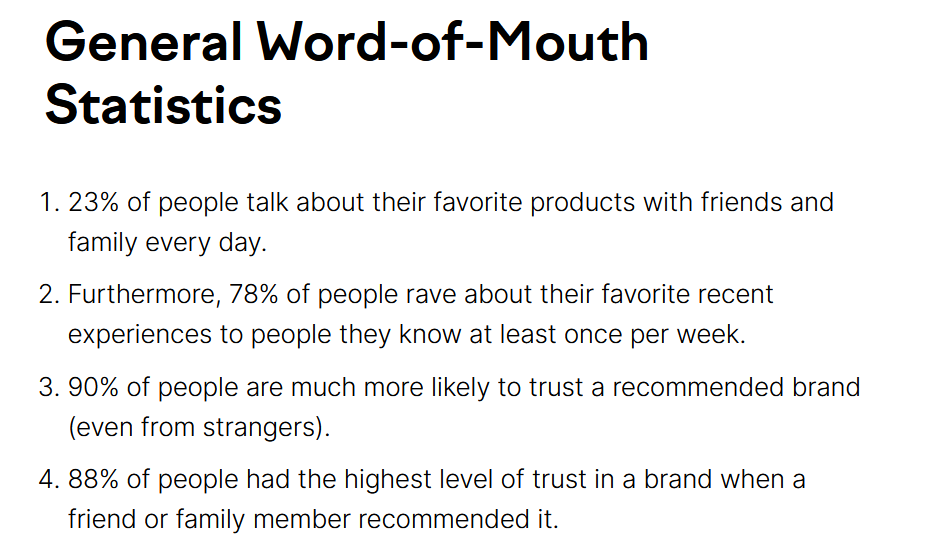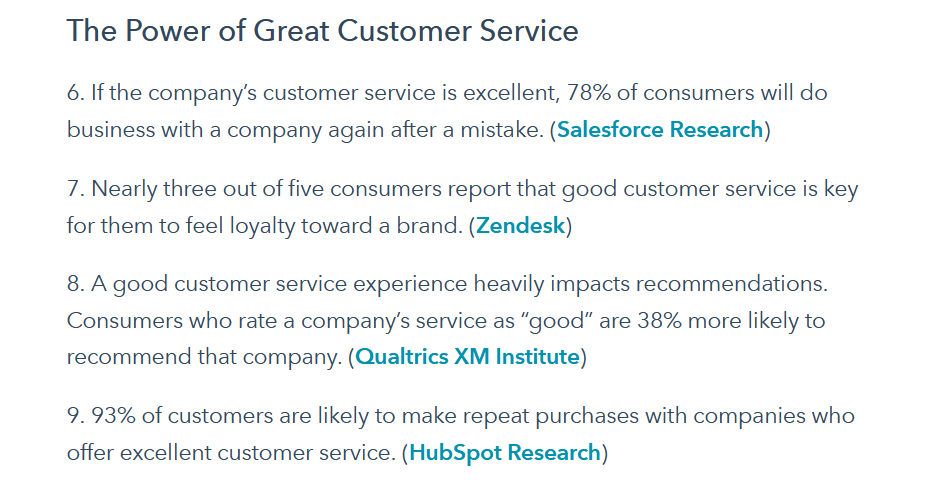Can you remember the last time you talked about a brand you love to a friend or family member? Maybe someone asked you about your most durable, yet stylish winter jacket, or your favorite coffee place. Those moments when someone asks you about your opinion to make an informed decision, and you point them in the direction of a specific brand, that’s you, advocating for that business. Sometimes, we’re so impressed by something a brand does or by a product we use that we tell our friends about it even if they don’t ask – an even more noteworthy version of advocacy done right. Advocacy marketing isn’t new, and it’s part of a larger notion called word-of-mouth marketing, or WOMM. As simple as it may sound, brands invest so much time and money to inspire customers to become their advocates. Of course, there are other options that fall under the realm of WOMM. You can, for example, create customer referral programs. You can also develop affiliate marketing programs, or invest in influencer marketing, all of which boost brand awareness and strengthen your reputation. However, turning customers into brand advocates calls for a specialized strategy and there are a few core steps you need to incorporate to make sure your buyers will start naturally advocating for your business. Let’s begin by demystifying the notion of customer advocacy and move on to specific steps you should include in your strategy.
Defining Advocacy Marketing
Although some forms of advocacy happen organically as the consequence of building a powerful brand, you can also implement a strategy that actively encourages advocacy. This kind of marketing requires you to provide customers with the means to spread the word and do so in line with your brand voice and values. When done right, customer advocacy is more effective, lasting, and comes with a higher ROI than any other strategy in your arsenal. Customer advocacy marketing is a great example of how powerful WOM is: research shows that 90% of customers are likely to trust a recommended brand, even when the recommendation comes from a stranger. In terms of profits, word of mouth creates over $6 trillion in global spending every year.

The goal of customer advocacy marketing is to: • Provide such an experience that your customers can’t help but talk about your brand. • Equip customers with the means and tools to advocate for your brand. • Express appreciation for customer advocacy to entice it even further. Even if it happens organically, you should show your gratitude to make sure they continue raving about your business. As you can see, advocacy is a closed loop of actions that help your brand boost awareness, authority, and engagement in one fell swoop. By implementing the right customer advocacy strategy, you can maintain that loop and slowly get more customers to become your advocates.
Step 1: Focus on Your Core Service/Product
No matter how many times you ask your customers to please rate your service or write a review, they won’t budge unless you give them a good reason to tell the world about your business. The only way to stimulate that kind of behavior is to actually provide a superior service or product that preferably exceeds customer expectations. From the moment you start your online business, focus on what your unique value proposition will be, and how you can deliver it so effectively that people will happily talk about your service. • Evaluate your brand offers to see how you can outmatch your competition. • Analyze your performance to spot improvement opportunities, both in terms of product/service quality, and the way in which you deliver that product/service. • Consider what makes your brand unforgettable. It can be an authentic packaging solution, an outstanding shopping experience, or the surprise gift they get with every buy. • Make sure your brand culture is up to par. If your employees are unhappy, your reputation is bound to suffer. To earn customer advocates, you also need employee advocates that genuinely love working with your business.
Step 2: Inspire and Encourage User-Generated Content
Much like affiliate marketers actively create content that talks about businesses they work with, you should empower your customers to advocate for your brand through user-generated content. • Create campaigns with unique hashtags for your customers to post content related to your business. You can reward the most creative entries! • Personalized thank-you notes that come with their purchase can remind them to leave a review. It’s unwise to incentivize with discounts and other monetary perks, though, as reviews should be unbiased and honest. • Invite customers to share their experience with your brand in more detail through a blog piece, a video review, or a testimonial. • User-generated content that honestly portrays your brand is one of the best ways to create brand advocates out of your customers. The more they engage with your brand through content creation, the more loyal they’ll be.

Step 3: Use Email Campaigns to Build Customer Advocacy
Using your list of existing email subscribers can be a powerful tool in reminding customers they can show off their loyalty to your brand. In addition to dedicated newsletters that invite customers to leave reviews, you can add a banner with your signature, reminding them of the option to write a review. Add a creative email signature for sales experts that interact with your customers to let them know where they can leave a review. You can add that colorful banner (with your brand’s colors, of course) with a clear CTA such as “We’d love to read your review!” and a link taking them to your review form. You can also send surveys via email to get a better grasp of how your customers perceive you – this will help you spot early customer advocates in the making and the qualities of your brand that most appeal to people.
Step 4: Leverage Social Channels as Customer Advocacy Platforms
Social media isn’t reserved for influencer campaigns only. In fact, even though people appreciate influencer reviews and are curious about the brands they support, they are equally “influenced” by regular people on these platforms. Social pages are great for generating buzz, but only when you actively engage your followers. Publish their reviews and enable star ratings for your business, as well. Make sure to respond to reviews to show that you value their input. Even negative reviews are opportunities to win someone over through outstanding customer support! This is how social media listening can increase customer advocacy.
Step 5: Start Conversations in Online Communities
Brand advocacy has evolved so far away from that in-your-face approach of old-school ads that it has enabled the creation of community marketing as a means to boost customer advocacy. SaaS companies use this approach best. They engage with existing customers in their communities regularly, to find out how they can improve their product over time. They also offer their own advice and guidance, positioning themselves as experts in their industries. Mimicking the same mindset, you can create your own digital community for customers to start conversations, provide company updates, and stay in touch with your audience.

Step 6: Foster Long-Term Relationships and Retention
Both B2C and B2B companies can use customer advocacy marketing, although the latter might require more time to accomplish the desired results. The sales cycle for a B2B company naturally lasts longer, so winning over a customer might be more costly, which means that you also might need to work extra hard to transform them into advocates. When you want to leverage advocacy in B2B marketing, you should remember the following: • Focus on building a relationship. It’s not as simple as “please review our product” when you’re dealing with business-level clients, so nurturing those bonds should be carefully planned and executed. • Ensure an incomparable brand experience every step of the way. Decision-makers come into contact with many businesses like yours, but few stand out enough to earn their support in the form of advocacy. • Much like in a good marriage, you cannot let the relationship go stale. Once you land the client, work on retention and adapt to your client’s needs.
Step 7: Rev Up Your Customer Service Efforts
Every problem is an opportunity to dazzle your customers with how quickly and effectively you resolve the issue. Every query is a chance to win over a customer’s loyalty, not just secure a purchase. And finally, every interaction with customer service is a chance to ensure a powerful recommendation. Studies show that a customer that rates your business as “good” is 38% more likely to recommend it, whereas 94% of American customers will recommend a business they rate as “very good”. Seems like a slight difference in ratings, yet it results in a staggering discrepancy in recommendations. The strategic steps you can take based on these numbers as you recognize the clear need for better service are as follows: • Use the right marketing channels to provide customer support, as well. Being where your customers are when they need you most makes all the difference. • Create a thorough FAQ page to make it easy for customers to find answers. • Use chatbots to provide immediate assistance and collect data on customer queries to improve your service. • Don’t ignore negative feedback – act on it and report back to your customer to let them know. They’ll love being heard and valued, and they’ll be much more likely to stay loyal to your brand. • Respond to comments and questions on social media. Yes, even the repetitive ones. • Make sure to train your staff on how to communicate your core brand messages and ensure a consistent brand voice across all support channels. • Never, ever leave your customers on hold. Waiting is not something a customer forgets, and rarely forgives.

Step 8: Be Active When Looking for Advocates
As we’ve already mentioned, customer advocacy will happen organically when your brand’s service is memorable and outstanding. However, that is no way to leverage advocacy as part of your marketing efforts. You need to play an active role to seek out, empower, and educate customer advocates. • Keep track of customer interactions to recognize emerging customer advocates. • Use social listening tools to notice when customers tag or mention your brand even outside of contests that you organize. Of course, respond and engage! • Create an affiliate program to provide a structured system for customers that are eager to work with your brand. • Set up a loyalty program to reward repeat business among your most devoted buyers. • Organize surveys to collect customer data and contact customers that show potential to be your advocates. Who knows, there might be a brand ambassador hiding in your subscription list.
Step 9: Simplify Advocacy Every Time
Finally, people are more likely to do something for a business if the process isn’t a hassle. Advocacy might happen in everyday conversations, and you should work on creating such a prominent presence to deserve that – but customer advocacy marketing requires you to simplify the process. By providing clear hashtags related to your business, you are one step closer to having more people tag and talk about your brand online. You can also create clickable elements such as social buttons to share your existing content and eliminate any effort on their end.




